Idli is a fluffy, moon-like steamed south Indian rice cake. Learn how to make the most perfect and authentic idli batter and idlis at home. These delicate idlis are not just fun to eat; like their close cousin, the exquisite dosa, they are full of protein and fiber and are really, really great for you. Even better, they are oil-free.
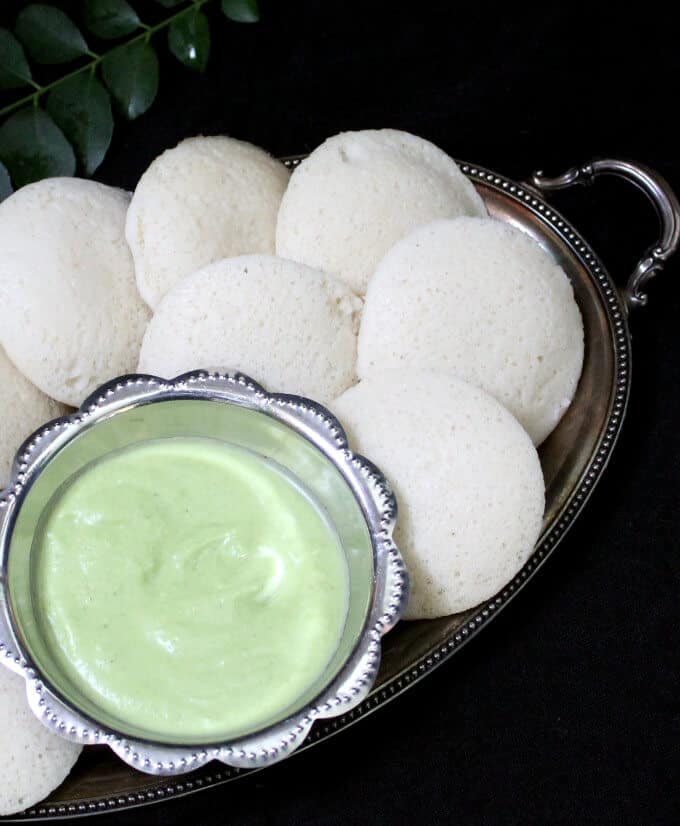
If you love fermented foods and understand the immense benefits they bring to your health, you should be making Idli, a five-ingredient food that originated in south India and has dug roots in kitchens across the rest of India and in Indian kitchens around the world.
South Indian dishes popularized by restaurants, like dosa, adai, sambar, and pongal, are usually immensely healthy. And that's more true of idli than almost any of these other foods. This porous, fluffy white disc could easily be the healthiest food in the world and it is made of two basic and very healthy building blocks -- rice and lentils. Eaten by itself, an idli tastes bland. But served with a sambar and a green coconut chutney, it becomes one of the most delicious foods you will ever eat.
This is also food for everyone--and anytime. Gluten-free? You can't do better than an idli with its perfect-protein combination. Trying to lose weight? Idlis are extremely low-calorie, fat-free and probiotic and can be great for weight loss. Sick? An idli will nurture your digestive system right back to health. Picky eater? No kid can resist a soft little moon to dunk into creamy, savory, green coconut chutney. And you can eat an idli at any time -- it makes a delicious south Indian breakfast, lunch or dinner.
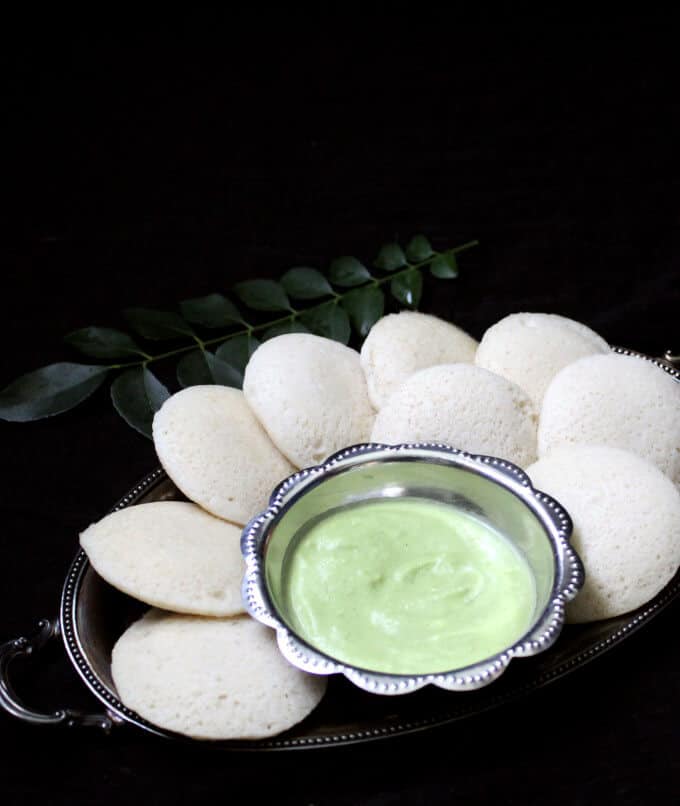
There are many kinds of idlis, but the recipe I have for you today is for a basic Idli -- the only way Idli was eaten before people started adding oats or cream of wheat or whatever to gild its perfection. And while I'm just as guilty as the next cook of improvising, this is also the idli recipe that gets made most in my home, because you never really can best a classic, can you?
Making an idli sounds simple enough, and making an idli batter is very similar to making a dosa batter. Both are made with rice and lentils, and both are typically fermented. But while a dosa is cooked into a crisp, golden crepe on a griddle, an idli is cooked by steaming it in a special mold. The proportions of the ingredients have to be balanced just right so you get an idli that sets up and solidifies perfectly when you steam it without becoming hard or dense.
You can rest assured you will get perfect results with this recipe because I've done all the hard work for you. If you follow instructions carefully, and make sure you use all of the ingredients in the exact proportions and follow the right times for soaking your rice and lentils and fermenting the batter, you can have the perfect idlis and eat them too.
You need just five ingredients for this idli recipe, including two kinds of rice. Some Indian recipes use idli rava instead of rice--a kind of coarse-ground semolina made with rice flour.
This idli recipe is healthier, because you can make the idli batter recipe using brown rice. I add the brown rice in combination with the parboiled rice that's typically used for making idli batter, and there's tons of healthfulness added to an already nutritious recipe with no loss in flavor or texture.
I also toss in a handful of flattened rice or poha, which I told you about not long ago in this Kande Pohe post, because it greatly improves the texture and fluffiness of the idli. You also need the fenugreek seeds to help the good bacteria thrive and flourish.
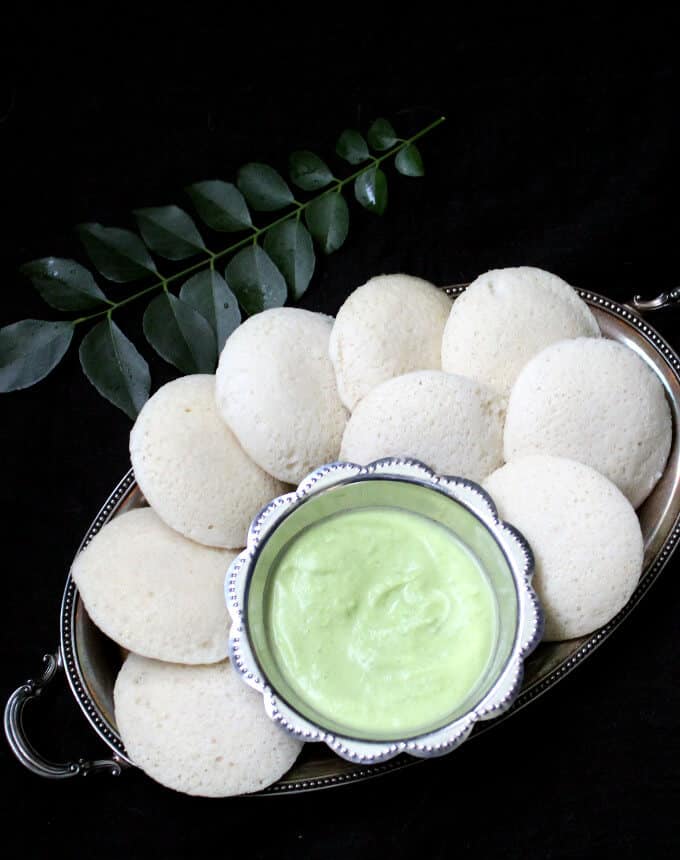
Idli ingredients
All of these are easily available at Indian groceries or online.
- Parboiled rice. This is the kind available at the Indian store, not the kind sold in supermarkets here in the United States. The rice is sometimes labeled idli rice.
- Brown rice (white rice is fine too). Use any rice you have on hand, including basmati rice.
- Black gram lentils or urad dal
- Flattened rice or poha/aval
- Fenugreek or methi seeds
- You don't need to add salt to the idli recipe although you can if you want to. Add it just before you steam the idli.
How to make idli
Make idli batter
- Soak rice and lentils: You need to soak your black gram lentils (urad dal) and the two rices -- regular or brown rice and parboiled rice -- separately and overnight. Soak the poha or flattened rice and the fenugreek seeds with the udad dal. Overnight is great, but you can also do this for about six hours in the daytime.
- Blend the idli batter: Once the lentils and rice have soaked, drain them and then grind them, again separately, with fresh cold water. The texture you grind each to is important for how your idlis will turn out, so don't try to make quick work of it by grinding them together. The lentils have to be ground into a very smooth paste, while the rice needs to be just slightly coarser. In India and online here in the U.S. you can buy a wet grinder designed specifically to grind idli and dosa batter, but you don't need one. A strong blender does a great job of making perfect and soft idli batter. I use my Vitamix and bonus, it takes a fraction of the time a wet grinder would.
Ferment idli batter
- Once you've gotten both the rice and the urad dal to the right texture, it's time to ferment the batter. To do this, mix the rice batter and the urad dal batter in a large bowl and set the batter aside to ferment for about eight hours, preferably in a warm place or in the oven with the light turned on. Once the batter has fermented, you will see it. The batter will look puffy and will rise quite a bit (it's a good idea to put a plate or a baking sheet under the bowl -- I've had to deal with an overflow of fermented dosa batter in the oven and it was NOT fun to clean up).
Steam idli
- You do need an idli mold to form the idlis (I added an affiliate link in the recipe card). It is not expensive and it'll last you a lifetime. In addition, if you are in India and have access to an inexpensive idli steamer you can use that to steam the idlis in. Otherwise a large stockpot with a lid that has a vent hole will do. If you use a pressure cooker, you need the kind that has a vent at the top on which you place the pressure regulator or "whistle". This is because you don't really want to pressure cook your idlis-- you want to steam them, so you don't need to put on the pressure regulator.
- When your batter is ready, lightly coat the individual plates in the mold with cooking spray. This is not absolutely essential, but it's something my parents did, and it makes the idli really easy to slide out after it's steamed. Now fill each little mold with the batter, stopping just short of filling it all the way up, because the idlis will puff up a little as they steam. To make the process of easier, I start out by filling the plate at the bottom, then place the second plate on top, fill that up, slide in the third, fill it up, and so on. If you were to fill in the molds first and them put the whole thing back together, you'd have a mess on your hands.
- Place the trivet in your pressure cooker or stockpot and add about an inch of water. Now place the idli mold on top of the trivet, put on the lid of the pressure cooker (without the pressure regulator on) or stockpot, and turn on the heat to medium-high.
- When you see wisps of steam beginning to escape from the vent on the pressure cooker or in the lid of your stockpot, set your timer to 10 minutes. Once your timer goes off, turn off the heat. I let the idlis stand in the stockpot for a couple of minutes, then carefully remove the mold and let them stand at least five more minutes before sliding them out. You need to apply light pressure with your fingers at the corners to ease the idli out.
What to serve with idli
Any kind of chutney or sambar is awesome. Here are some more suggestions:
I used the coconut chutney this time. Now here is the recipe for a really delicious, fluffy, amazing idli that'll go right to the top of your list of south Indian breakfast favorites.
Frequently asked questions
You definitely can. Place a cup of water in the IP insert, set to "saute" and bring the water to a boil. Place the idli mold with the batter in the liner, click the lid in place, and set the Instant Pot to "steam" at high pressure. Leave the vent open. Set an external timer for 12 minutes and steam the idlis. Once the timer goes off do a quick manual release and remove the idli mold from the IP.
This can happen if you didn't oil the idli molds before adding the batter to them, or if you undercooked the idli. Make sure you oil the idli molds and to check if the idli is done insert a toothpick and ensure it comes out clean.
Yes, you certainly can consider this an idli dosa batter that you can use to make both recipes.
Idli batter can be frozen for up to three months. Place in an airtight container. Thaw thoroughly before making idli.
To freeze idlis, place them in a freezer safe container or bag and freeze for up to three months. Thaw or defrost thoroughly and warm in microwave before eating.
A hearty serving of four idlis has just 175 calories, 6.3 grams of protein and nearly 3 grams of dietary fiber. It also has just 1 gram of fat. Combine the idlis with a homemade coconut chutney and you will have a complete meal that will make weight loss as fun as can be.
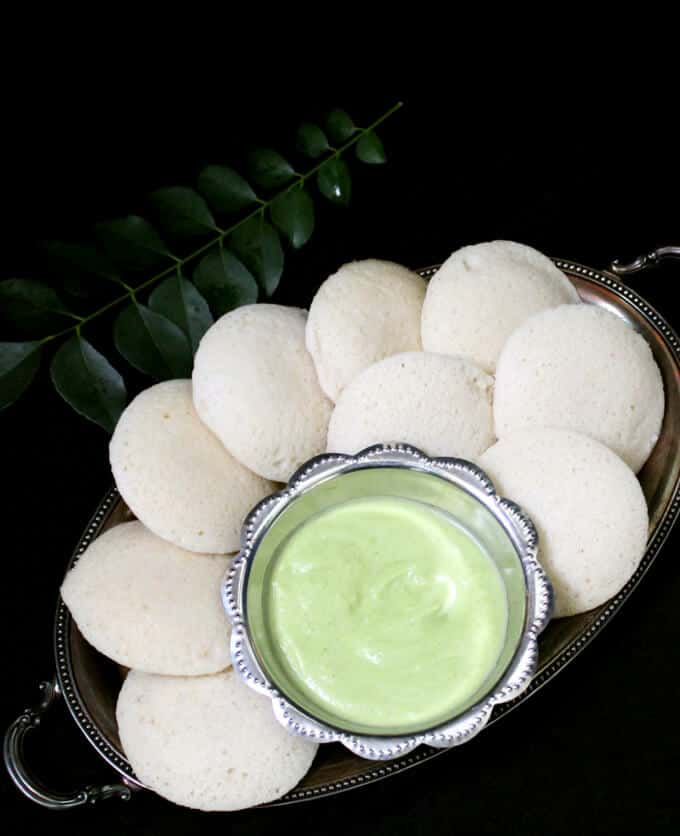
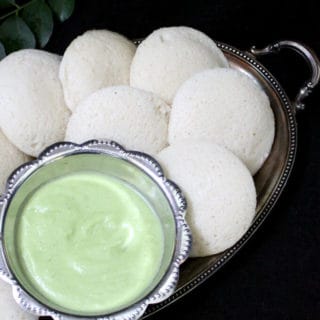
Idli recipe
Equipment
- Large stockpot or pressure cooker
Ingredients
- 1 cup black gram lentils (udad dal)
- 1 teaspoon fenugreek seeds
- ¼ cup flattened rice (poha)
- 1 cup parboiled rice
- 1 cup brown rice (white rice is fine too)
Instructions
Make the idli batter:
- Place the black gram lentils in a bowl with the flattened rice and fenugreek seeds and cover by at least two inches of water. Set aside to soak at least six hours or overnight.
- Mix the parboiled rice and brown rice in another bowl and cover them with at least two inches of water. Set aside, again for at least six hours or overnight.
- Drain the lentils and grind them in a high powered blender, adding just enough water to get a batter that's the consistency of a thick pancake batter. The batter should be very smooth. Remove the batter to a large bowl.
- Add the rice to the blender, again with enough water to create the consistency of a thick pancake batter. This time, grind until the batter still has a slight coarseness -- you don't want to see broken grains of rice, but the batter should have a slight grittiness, like that of cornmeal, when you rub it between your fingers.
Ferment the batter:
- Add the rice batter to the lentil batter and mix them both, preferably with your very clean hands. The reason for this is that the warmth of your hand helps start and hastens the fermentation process.
- Cover the bowl very tightly with cling wrap. Your bowl should be large enough that the batter reaches only half way up because the batter will rise. If you're not sure, slide a plate or a baking sheet under your bowl to catch any overflow.
- Place the bowl in a warm place or in a cold oven with the pilot light turned on and let it stand overnight or at least eight hours. By that time it should have become puff and risen.
Steam the idlis:
- In a steamer or a large stockpot with a vented lid that lets steam escape, or in a pressure cooker with a removable pressure regulator, place a trivet and an inch of water.
- Spray the idli molds lightly with cooking spray and fill them up, stopping just short of filling them up all the way because the idlis will puff up a bit as they steam. I first fill in the bottom-most plate of the mold, then slide on the second one, fill it up, slide on the third, fill it and so on.
- Place the idli mold in the stockpot or pressure cooker and cover with the lid. Do not put the pressure regulator on the pressure cooker vent.
- Place your stockpot or cooker on medium-high heat. When you see wisps of steam rise from the vent in the lid or the pressure cooker, set the timer to 10 minutes and let the idlis steam away. At the end of 10 minutes, turn off the heat and let the idlis stand for a couple of minutes before opening and removing the mold.
- Disassemble the mold and let the idlis stand in the plates for another five minutes or so. Then slide them off, either with your fingers or with a spoon.

Shaheen
i like your recipe very much, need more related recipe
Antoinet
Hi there,
Thank you for the amazing recipes.
Can I make these without parboiled rice?
Vaishali
Hi Antoinet, you don’t have to use parboiled rice. Just use more of the white or brown rice instead.